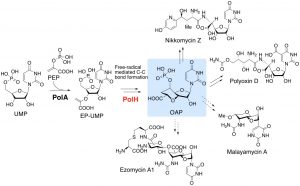Antifungal Biosynthesis
The incidence of fungal infection has been increasing in the past decade, but our current treatment option is limited due to the toxic side effects of the existing molecules and increasing drug resistance. Inhibitors of fungal cell wall biosynthesis have been found in Nature, and exhibit highly potent and selective antifungal activities. While some of these antifungal molecules have been successfully used in clinics, many others have not been clinically exploited. We are studying those molecules with the long-term goal of providing the novel and clinically useful antifungal agents.

Our current focus is the biosynthesis of the peptidyl nucleosides (PN) antifungals that inhibit chitin synthase. PNs inhibit chitin synthase, enzymes essential for fungal cell wall formation, and provide potent in vivo activities against some of the pathogenic fungi. These molecules are also synergistic with the clinically used antifungals, such as echinocandins. Therefore, the development of these molecules will strengthen our current antifungal chemotherapy. To provide novel chitin synthase inhibitors, we are taking chemoenzymatic and biosynthetic approaches to diversify the drug discovery efforts.

Very recently, we discovered a radical SAM (S-adenosylmethionine) enzyme, PolH, that catalyzes the key C-C bond forming reaction using a unique free radical-mediated mechanism (
Nat. Chem. Biol. 2016). Our functional and mechanistic characterization of PolH combined with bioinformatics analysis suggested that such a mechanism is likely conserved among antifungal C5′ extended nucleoside natural products. Our current genome mining project will provide further insights into the mechanism of their biosynthesis and aid in the discovery of novel antifungal nucleoside natural products.


